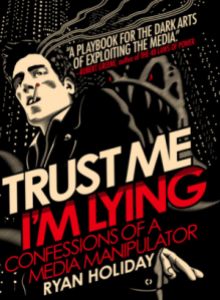Did Barack Obama Rape a Kitten?
Fifteen cats were sighted near the White House this afternoon. A reader reports that allegations may have surfaced concerning the president’s rapage of felines. Calls to the White House have gone unanswered.
Before you question my reporting ethics, let me remind you how much you paid to read this blog. Yeah, you’re not the customer and I owe you nothing. The real customers here are my paid advertisers, and they want impressions to place their ads against. They rarely make a qualitative judgment about what content their ads appear next to.
Here:

TechCrunch, Forbes, Buzzfeed, Re/code. They all rely on advertisers for revenue, which means that their sole purpose in life is not to inform, but to linkbait. The Financial Times features ads for Cartier watches and chartered jets; its articles are crafted to bait rich people. TechCrunch runs ads for cloud services. Huffington Post displays ads for Seven Weird Tricks to Reduce Belly Fat.
Ryan Holiday ran the PR campaign for Tucker Max. Tucker Max was an average 20-something with a mediocre book and a terrible movie, until Holiday instigated a bunch of media coverage based on fabricated events. If you’ve ever heard of Tucker Max, you can thank Ryan Holiday.
This is a summary of Holiday’s book on media manipulation. I present his tactics out of order because I think it makes more sense this way.
-
9. Make stuff up. Everyone else does. Bloggers (by which I mean writers on any ad-supported publication – I don’t think Buzzfeed or TechCrunch posts count as “journalism”) get paid by the pageviews generated from each post. A Gawker writer churns out 12 posts a day and makes an average of $8 per post. Nobody has time to research 12 articles a day. They don’t even have time to write 12 articles a day — most of it’s plagiarized.
9.5. News trickles up. TechCrunch might not report something that an anonymous tipster sends in, but they’ll copy something that was reported by the San Mateo Daily Journal. And the San Mateo Daily will report a story from a random email, because they’re a crappy local paper.
Ryan Holiday emailed a bunch of local news reporters around the country pretending to be a college student staging a feminist protest against Tucker Max’s movie. National news reporters picked up the story that protests were being organized on college campuses around the country. Then college students began staging real protests.
2. Feed the sources that reporters use. Push press releases onto PRWeb. It costs $99, and PRWeb is automatically syndicated by Associated Press and fed into Google News. Pretend to be an expert by answering questions on HelpaReporter.
3. Stuff that makes people angry spreads the fastest. If you can’t come up with something divisive, try something shocking.
4. Be evasive and misleading. Start a petition titled “Stop Marc Andreessen from Using LP Funds to Pay for Illicit Affairs” and tell local news. Let writers report the most sensational angle they can find.
8. Make sure the story is simple enough to fit within 100 words. Nick Denton, founder of Gawker, says the ideal Gawker post is 100 words, 200 max.
5. RSS is dead. Nobody subscribes to anything, so blogs care less about their reputation than they do about creating viral posts. News spreads through Twitter, not RSS feeds.
6. People tweet headlines. Make it controversial and throw in big names for SEO. News bloggers don’t expect the tipster to write the headline for them, but hint at it in the tip.
7. Buy traffic for your article. Use StumbleUpon or Outbrain, show these news sites that your story is a reliable traffic draw so they will write follow-on stories in the future.
1. If you are looking for positive PR, bribe bloggers. Send them product samples, swag, whatever. They’re poor and can’t afford nice things.
So did the president rape a kitten? I don’t know, whatever. We’ll have more details as the story develops.

